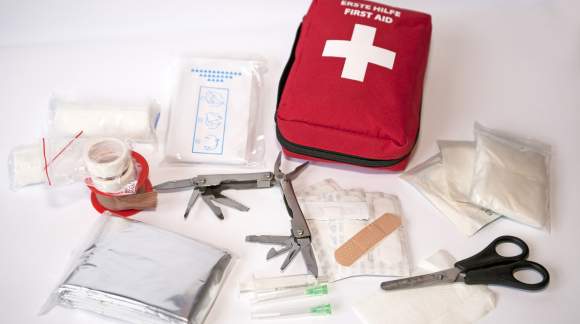First Aid-Basic Prep Kits

Preparing for Your Personal Safety
Creating a first aid kit is something you may not consider until you are standing with your screaming child looking for a Band-Aid. A little pre-planning can go a long way when time is tight and running to the store for supplies is not an option.
First aid kits vary in size. For some families a plastic baggie of Band-Aids, anti-itch cream and aspirin will suffice. For others, a mini reproduction of the medical isle is a must.
Check out this list of recommended items to include in your first-aid kit from the American Red Cross. When assembling your first aid kit, it is helpful to consider the most common types of accidents that occur in your household so that you can accurately prepare.
The following are typical accidents in young children that a first aid kit can address:
- Insect bites (ants, bee stings)
- Minor burns
- Minor cuts
- Road rash
- Carpet rash
- Lost tooth
- Loose, lost toe or finger nail
- Bloody lip
- Bloody nose
- Nose or ear blockages
- Splinters
- Fever
- Swollen eyes, lips or wrists
The Red Cross recommends keeping supplies in multiple places—anywhere you think an accident might happen – including cars (one for every vehicle), boats, kitchens, bathrooms, RVs, office, classrooms, and any other place you or your children spend a great deal of time.
First Aid Safety Like a Pro
Employ the tips below to build, maintain and utilize a first aid kit in your home, office or car:
- Store your first aid kits in a place that is easily available, but out of the reach of small children.
- Keep a kit in every car you own, as well as other recreation vehicles like boats and RVs.
- Purchase a travel size kit for vacations and small day trips like the pool or camping.
- Check the kit annually for any medications that may have expired.
- Children who are old enough to understand the need for an emergency kit should know where it is located and how to use basic items.
- PRO TIP: Make learning how to use the first aid kit a fun afternoon activity with the kids.
- Include a list of important phone numbers in your kit (emergency contacts and the local police, firehouse and hospital locations and phone numbers)
- As soon as you remove something from the kit, replace that item.
- PRO TIP: Every May, at the start of summer, plan time to review your kits for missing products.
- Keep your first aid kit properly labeled so it is identifiable by other people in your home like in-laws, friends, and babysitters.
- PRO TIP: The most common look for a first aid kit is a clear box with red font.
- Store it in a cool, dry place.
- Consider the needs of every family member and be sure to note medication allergies of anyone in the family.
- Consider also preparing a survival kit for natural disasters that are common in your area.
Don’t let the fact that you have not used your first aid kit in several years be a reason to stop maintaining it. It’s just like insurance, using your home first aid kit even once for an emergency for the health and safety of a loved one, is worth maintaining it for years.
Additional Resources
- Survival Gear: Disaster, Emergency Preparedness, Camping and Survival Support, by first-aid-product.com
- Prepping 101, by modernsurvivalists.com
- Top 10 Things to Get to Start Prepping, by modernsurvivalonline.com
- A 21-Piece First aid Kit, by preppingtosurvive.com
- 12 Survival Items You May Have Overlooked, by Pat Henry@prepperjournal
- First-aid Kits: Stock Supplies That Can Save Lives, by Mayo Clinic Staff
- Emergency Kit Backpacks, by Quill.com
- Prepping First Aid Skills and Supplies, by imperfectlyhappy.com
Videos
- The Survival First Aid Kit Checklist: Do You Have Everything, by sasionline.org
- Prepper First Aid Supplies, by TheBuckeyePrepper
- Prepping, First Aid Overview, by orthaNZ
Education
- CPR and AED Certification, by American Health Care Academy
Books
- Prepper’s Survival Pantry, by Evelyn scott
- Preppers Survival Medicine Handbook, by Timothy S. Morris
- Getting Home in an Emergency, by Jay Whiteley
Apps
- First Aid by American Red Cross, by American Red Cross, available on iTunes for free
- USMLE Step 1 First Aid Q&A, by gWhiz, LLC, available on iTunes for free
